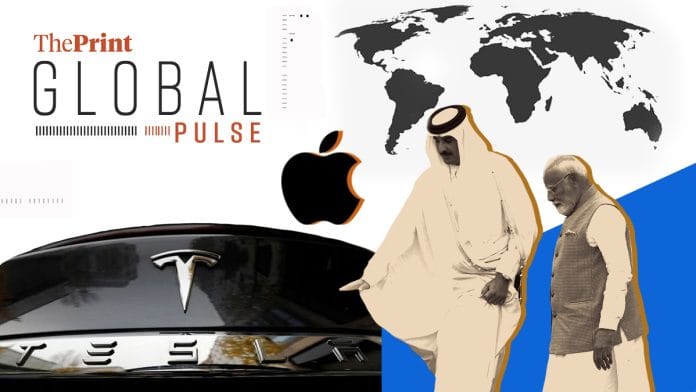New Delhi: Apple has been quietly pivoting to India, reports the Financial Times. Can the world’s largest democracy deliver?
Mobile phones have now surpassed diamonds as India’s biggest product export. Around 15 percent of Apple’s iPhones are currently being made in India—which ThePrint has reported on in the past—and this is expected to increase to 25 percent by 2027.
“For Apple’s chief executive Tim Cook, the geopolitics surrounding the shift are tricky. Apple—which is intensely secretive about its supply chain—needs to be wary of antagonising China, on which it still overwhelmingly depends,” reports FT. “Complicating matters further is the chilly relationship between Beijing and New Delhi. In a sign of the secrecy and political sensitivities, officials in Karnataka and Tamil Nadu refer to Apple even in private conversations as ‘the fruit company’.”
Apple’s growing business in India is being viewed with some suspicion in China. Beijing recently hampered the movement of Chinese technicians and capital goods into India. But the stakes of Apple’s relationship with India are very high for the Modi government, reports the Financial Times.
“With unemployment hovering at about 10 percent and millions of young people about to enter the labour force, the clock is ticking. Anger over the issue during last year’s election led to Modi’s Bharatiya Janata party being reduced to a minority for the first time in a decade and forced into a coalition,” reports FT. “But if Apple is to put down deep roots in India, it will need a supply base there to rival its vast network in China.”
The iPhone is only being assembled in India, with parts flown in. Component manufacturing is the need of the hour.
“The iPhone 15 was India’s top-selling smartphone model in the December quarter, and Apple now claims a 23 percent share of the market’s revenue, ahead of rival Samsung’s 22 percent,” reports FT. “Yet India remains a relatively small consumer market for Apple, selling less than a quarter of the number of iPhones it sold in China last year, according to independent estimates.”
On the ground, the signs of how far India has come are clear, according to FT. Just look at the fact that India is now making Apple’s most advanced iPhone, the iPhone 16 Pro.
Qatar has committed to investing $10 billion in India across various sectors, following a meeting between Prime Minister Modi and Qatar’s Emir Sheikh Tamim bin Hamad Al-Thani, the first such visit by a Qatari Emir to a South Asian nation in a decade.
“Qatar will invest $10 billion in India in infrastructure, technology, manufacturing, food security, logistics, hospitality and other sectors,” reports Reuters. “The two countries will aim to double their annual trade to $28 billion in the next five years and are exploring the signing of a free trade agreement, the Indian foreign ministry said earlier in the day.”
Qatar accounted for more than 48 percent of India’s LNG imports in 2023, reports Reuters.
This share might start shifting now that India has committed to importing gas from the US, according to the Financial Times.
FT reports that while Russia is the main supplier of crude oil to India and Qatar the biggest provider of LNG, the US is the world’s largest LNG exporter, accounting for a fifth of India’s supplies in 2024.
India is one of the last untapped markets for gas globally which has a huge scale, according to experts quoted in the FT story. “In a report released last week, the International Energy Agency said India’s natural gas consumption would increase by nearly 60 percent by 2030, with LNG imports set to more than double in the same period driven by steady demand growth and a much slower rise in domestic production,” reports FT. “In 2023, India’s total net gas production met just about half of its demand.”
“Yet the long distance between the US and India, compared with shorter shipping routes for Middle Eastern suppliers, and the technical challenge for Indian refineries of switching between different types of crude, could limit imports,” FT reports.
US oil and gas exporters might welcome increased Asian trading opportunities, but a peace deal between Russia and Ukraine could result in the resumption of cheap Russian pipeline gas into Europe—which would then disrupt the more expensive US LNG supplies sent by ship. Either way, the US is willing to provide and India seems willing to buy.
Meanwhile, Global Times offers its two-cents on Tesla entering India: “while India’s electric vehicle (EV) market is still nascent compared with China’s, it offers an avenue for Tesla to check slowing sales,” it writes.
The news of Tesla’s entry into India, Global Times points out, comes at a time when it is experiencing its first annual decline in EV sales in a decade. Its prospects in South Asia remain “clouded by multiple challenges,” like a weak manufacturing base, protectionist tendencies, and a relatively less stable investment environment for foreign enterprises.
After listing out the numerous regulatory and production challenges Tesla is bound to face in India, Global Times offers some advice to India: to boost industrial development, India needs to not only reduce tariffs, but also “continue optimizing its policy environment while embracing international industrial chain cooperation and enhancing the level of infrastructure construction.”
Even Chinese car manufacturers recognised the vast market potential in India, but faced setbacks—including “security concerns”, the article says.
“If India’s EV industry wants to develop, it cannot avoid collaborating with China on the supply chain. China’s key role in Tesla’s global supply chain is evident. If India chooses to ignore the current realities of global cooperation in the EV industry, both Tesla’s future development in India and the development of India’s own EV industry will face significant uncertainty,” Global Times says.
(Edited by Zinnia Ray Chaudhuri)






